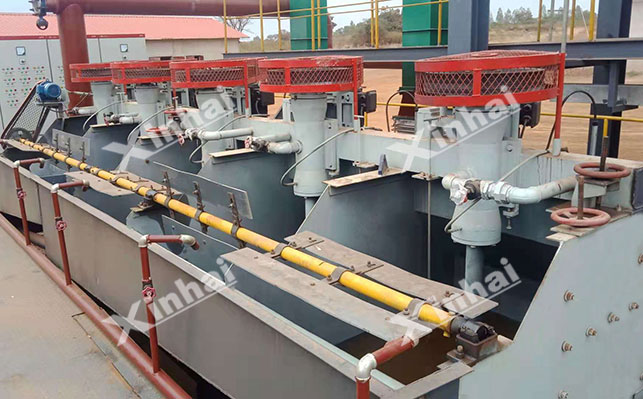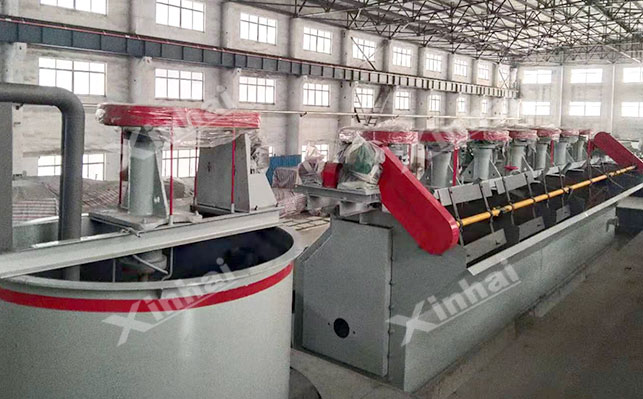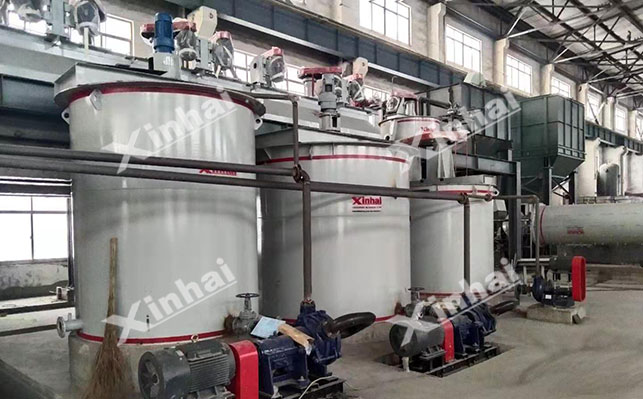
15311826613
Click to add WeChatWith long-term mining, the abundant copper, molybdenum and other ores have been basically mined out, while the demand for mineral resources in modern industry has only increased. Therefore, expanding the amount of available resources and recycling resources are new development directions. Minerals are non-renewable resources, and recycling is difficult. It is necessary to develop difficult-to-select ores as much as possible. Traditional beneficiation processes face huge challenges for beneficiation of difficult-to-select, fine-grained or severely weathered ores. New process methods are breakthroughs. At present, many research institutions and universities have begun to develop new beneficiation process technologies. Let's take a look at some new types of copper-molybdenum ore beneficiation processes.

Collector flotation process is a new process that floats molybdenite without using a collector, roughs tailings and then uses a strong collector to float molybdenite. For example, a polymetallic molybdenum ore containing copper, manganese, lead and zinc is ground to P80=100μm by a ball mill. Without adding any molybdenite collector, only a quantitative frother (MIBC methyl isobutyl carbinol) is added. After roughing, a rough concentrate containing about 11% Mo is obtained. Then, it is re-grinded by 3-stage gravel mill and multiple concentrations. During the process, water glass is added for flotation, and finally a molybdenum concentrate with a high content is obtained.
The flotation process of talc-containing copper-molybdenum ore is a new process, which is completely different from the traditional process. During flotation, the molybdenum ore and talc are first suppressed by CMC, then the molybdenite is activated to suppress the talc, and then the molybdenite is suppressed to float the talc, forcing the two to be fully separated. For example, a copper-molybdenum ore contains copper, manganese, iron, magnesium and other elements, among which copper minerals mainly include chalcocite, covellite, bornite and chalcopyrite, while molybdenum exists in the form of molybdenite. After grinding to P80 = 150μm, potassium amyl xanthate and diesel are used for copper-molybdenum mixed flotation. The obtained rough concentrate is re-grinded to -0.038mm accounting for 80%, and lime is added to inhibit the associated pyrite. The copper-molybdenum sulfide ore is refined again, and both the rougher tailings and the selected tailings are discarded and sent to the tailings pond.

Then, the primary rough concentrate is subjected to equal flotation, and a certain amount of CMC carboxymethyl cellulose is added and stirred to make the carboxymethyl cellulose molecules adsorbed on the surface of molybdenite. Then, a copper concentration is carried out. While floating copper and suppressing molybdenum, talc is also suppressed. The concentrate of the primary concentration is stirred with CMC and then subjected to a secondary copper concentration to obtain a copper concentrate. The tailings of the primary copper concentration and the secondary copper concentration are combined and 90°C steam is introduced into the stirring tank for 30 to 60 minutes to desorb the CMC adsorbed on the surface of the molybdenite in the previous flotation operation and make it inactive. Then, a molybdenite collector and a small amount of frother are added to carry out a molybdenite flotation, and then a scavenging is carried out. The scavenged foam is returned to the regrinding operation.
The concentrate of the first molybdenum concentration still contains a certain amount of floating talc. In order to suppress this part of talc, a small amount of sulfuric acid is added to the concentrate to acidify the pH of the pulp to 1.3-1.9, so as to suppress the talc. After acidification, the second molybdenum concentration is carried out. The tailings of the second molybdenum concentration are mainly talc, but the floating talc in the foam of the second molybdenum concentration is still difficult to suppress. In order to further separate the talc and molybdenite, the concentrated concentrate is roasted at about 250℃ for 30-40min to remove the diesel adsorbed on the surface of the molybdenite. Light burning can also cause the surface of the molybdenite particles to be slightly oxidized to form a molybdenum oxide film, which reduces the floatability of the molybdenite. After the light burning, the concentrate is then added with methyl isobutyl methanol to float the talc, and the talc is floated on the tailings. Alkali is added to adjust the pH to about 9, and then the first concentration is carried out to obtain the molybdenum concentrate.

It is difficult to obtain a relatively ideal recovery rate by using traditional beneficiation technology for difficult-to-select copper-molybdenum ores. Therefore, some researchers have developed a combined beneficiation and smelting process. The process is to obtain a low-grade molybdenum concentrate containing Mo, Cu, and S by a roughing process of copper-molybdenum mixed concentrate, and then carry out oxygen pressure oxidation treatment to finally obtain a molybdenum product of pure molybdenum trioxide.
The process of flotation-oxygen pressure oxidation is to crush and grind the copper-molybdenum ore, use lime as a regulator, use xanthate collectors and diesel together, and use methyl isobutyl carbinol and isooctyl alcohol as frothers to float out the copper-molybdenum mixed concentrate.

Sodium hydrosulfide is used as a copper sulfide mineral inhibitor. In order to strengthen the inhibitory effect of sodium hydrosulfide on copper sulfide ores and reduce the dosage of sodium hydrosulfide to prevent the rapid decrease in the potential of copper-molybdenum flotation pulp, industrial nitrogen is added to the flotation operation (flotation tank). After copper and molybdenum are separated, two products are obtained, namely, molybdenum concentrate containing Mo and Cu and copper sulfide concentrate containing a small amount of molybdenum and Cu.
The molybdenum concentrate is then mixed with water to form a solid slurry, and a certain amount of copper chloride and acid are added to the slurry. The slurry is subjected to oxygen pressure oxidation at 150°C and 1480kPa for 1 hour. After oxygen pressure oxidation, the slurry is discharged from the autoclave and filtered. The filtered filter cake is washed, and the pH of the filtrate is 0.91. The final copper leaching rate is 96.2%, and the molybdenum leaching rate is 1.6%. The filtrate is combined with the product of oxygen pressure oxidation of copper concentrate, and the copper is extracted and enriched with a solvent. Then, a copper sulfate solution is stripped and electrolyzed to obtain electrolytic copper after purification. Hydroxy oxime is used as the copper extractant, and kerosene is used as the solvent. A small amount of molybdenum in the aqueous phase after copper extraction is recovered.
The flotation-oxygen pressure oxidation process can enrich molybdenum concentrate containing 0.5% to 10% Cu to a high-grade molybdenum concentrate containing about 0.1% Cu. At the same time, the oxidation temperature of this process is as low as 150℃, and the pressure is as low as 1500kPa, which can also reduce the amount of NaHS used during flotation.
The above is an introduction to several new copper-molybdenum ore dressing processes. The selection of process flow in the actual beneficiation plant needs to be based on the properties of the ore and the processing volume. Therefore, it is recommended to conduct beneficiation experimental analysis, and then design a suitable copper-molybdenum ore dressing process based on the actual situation.